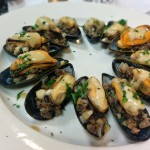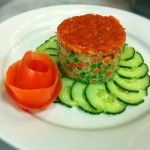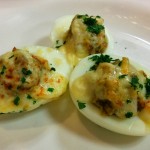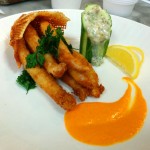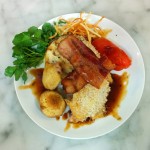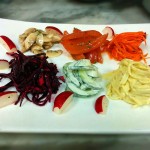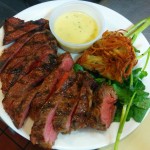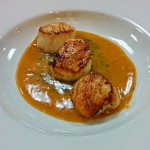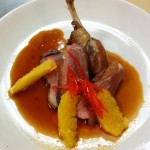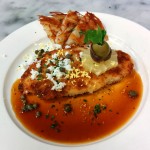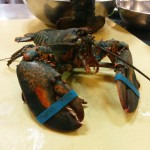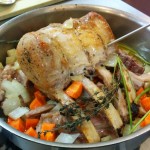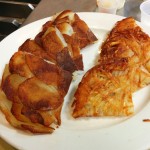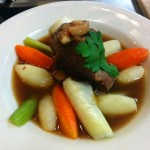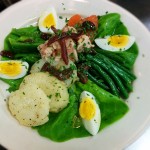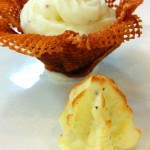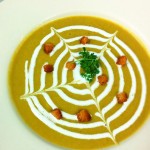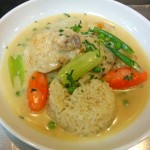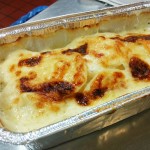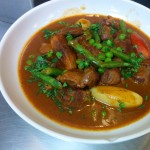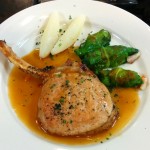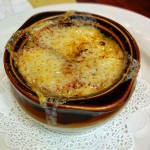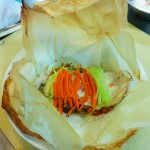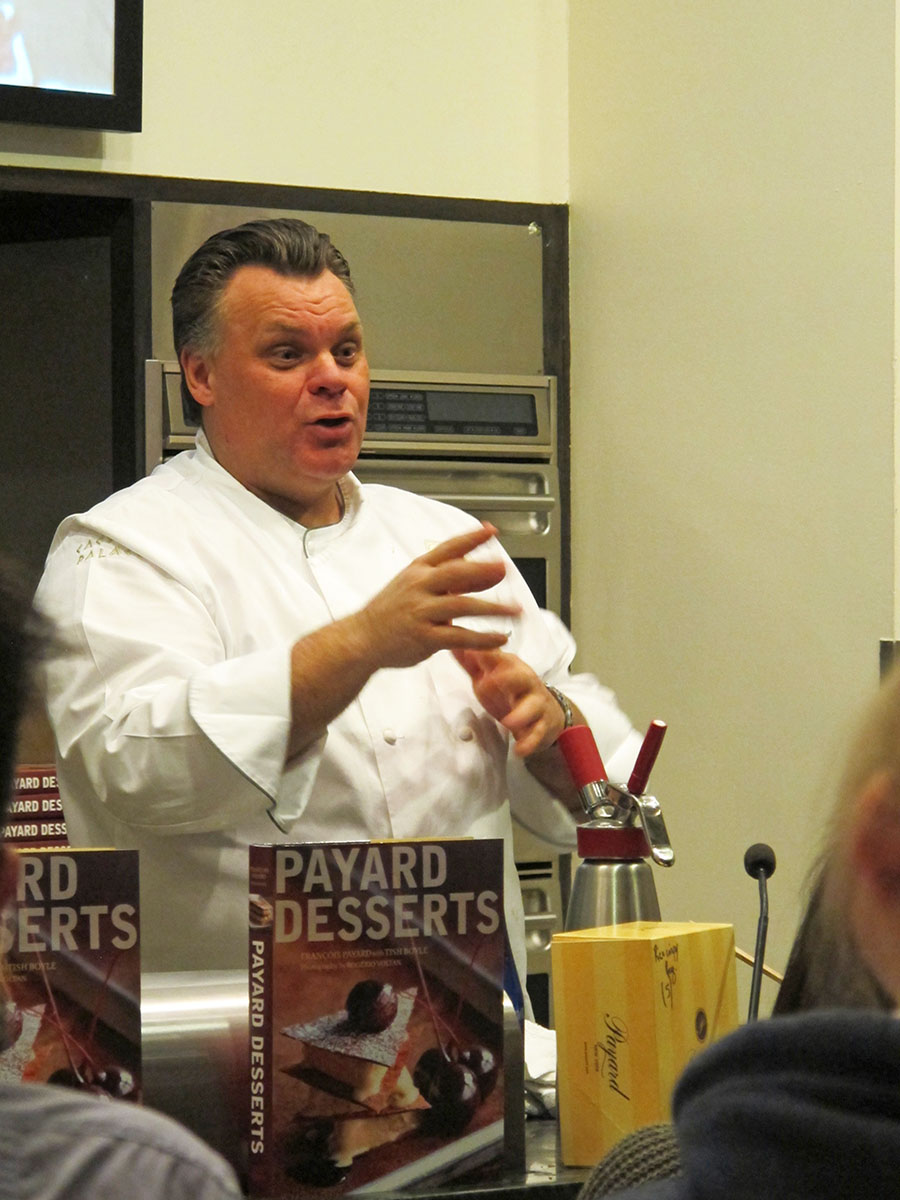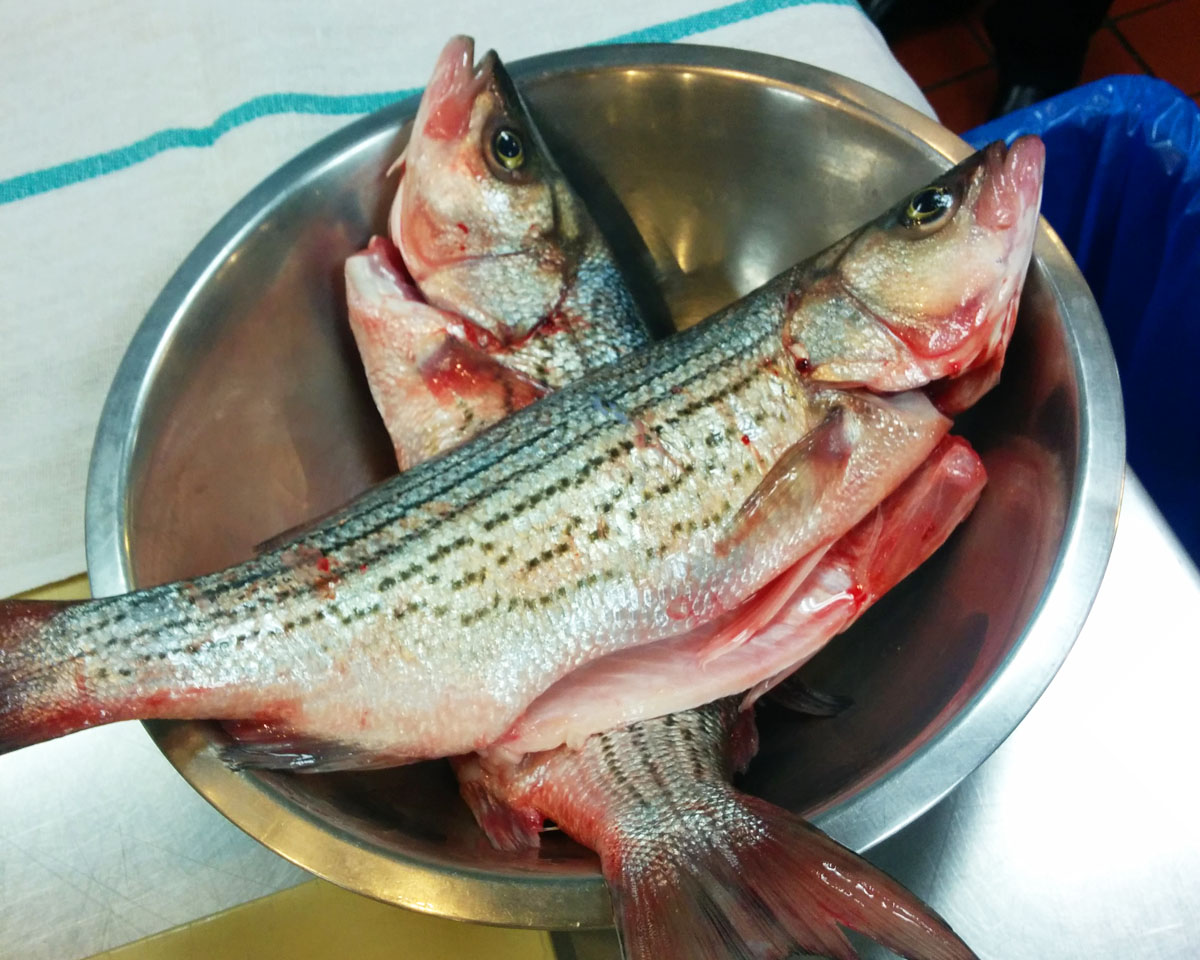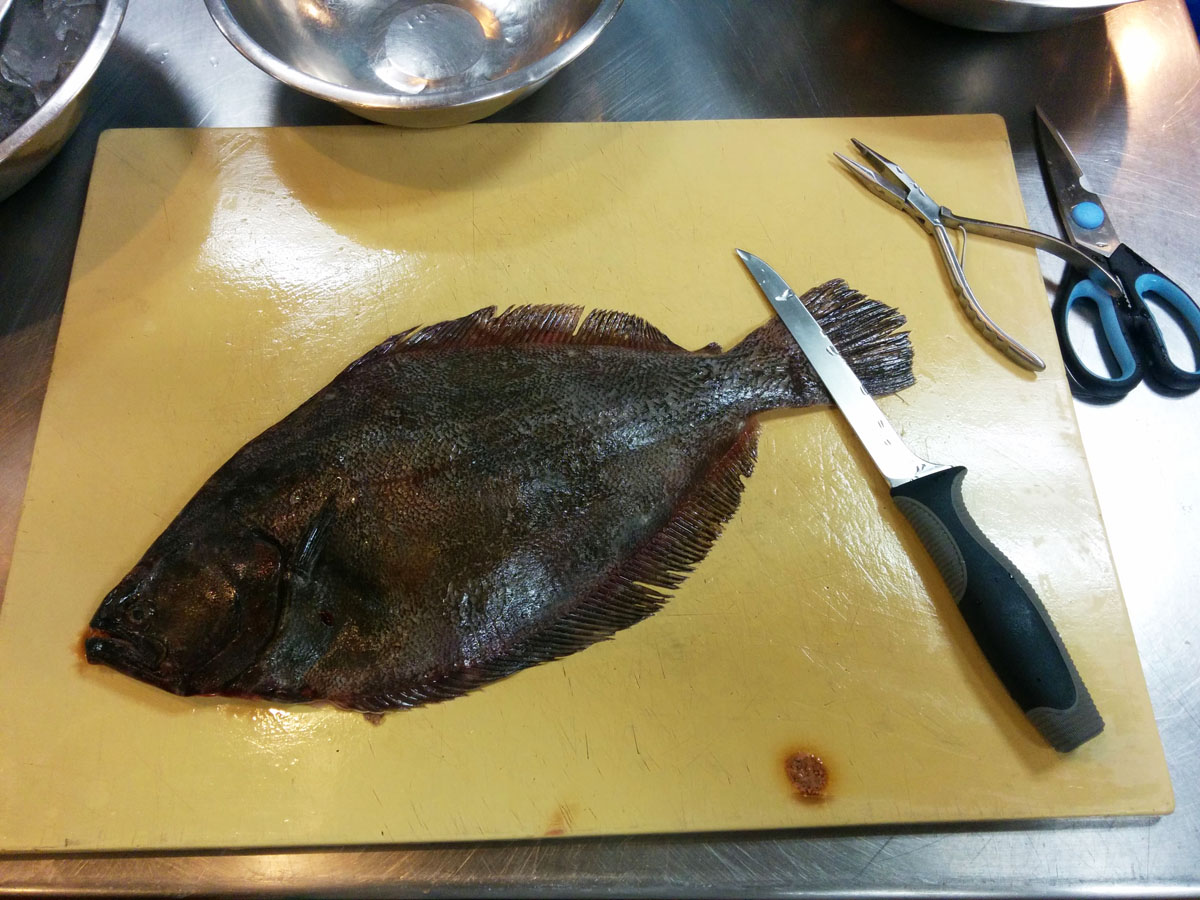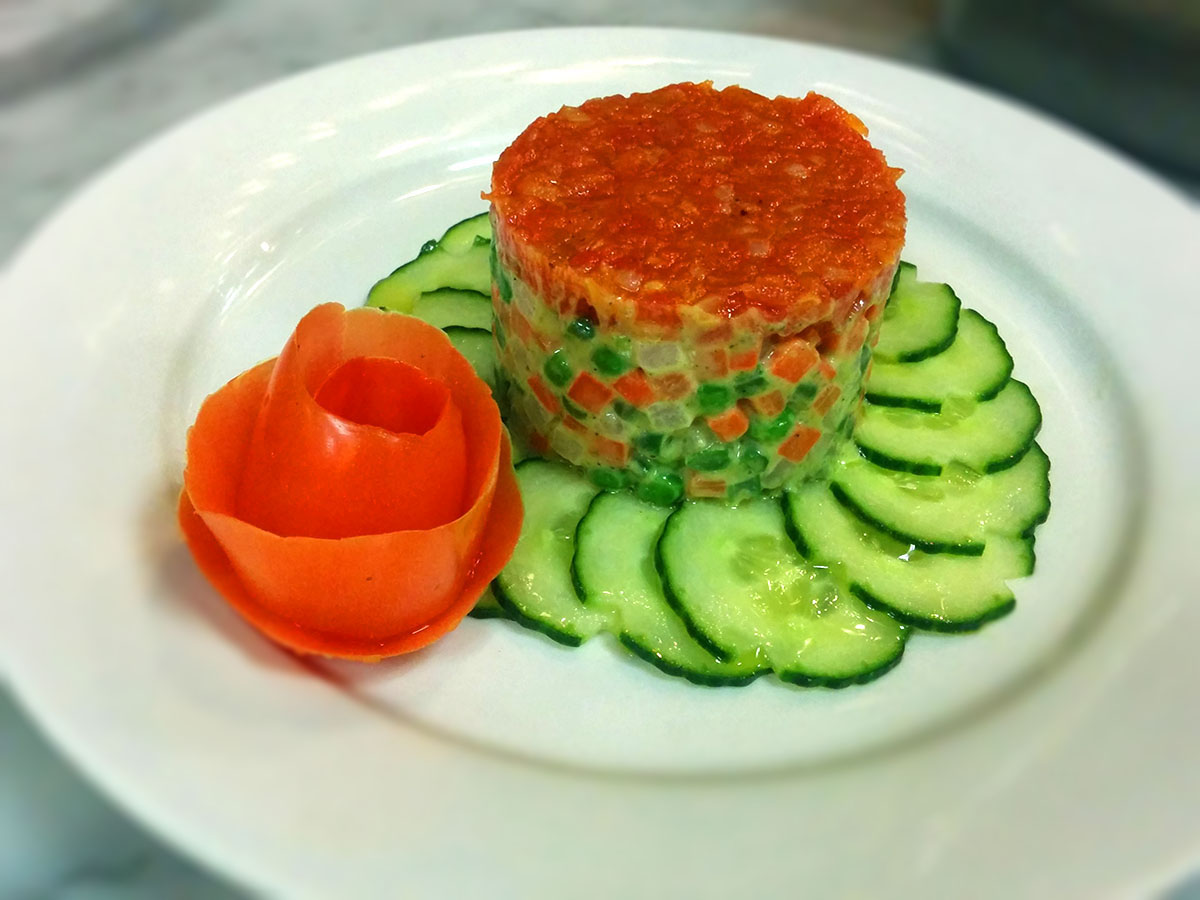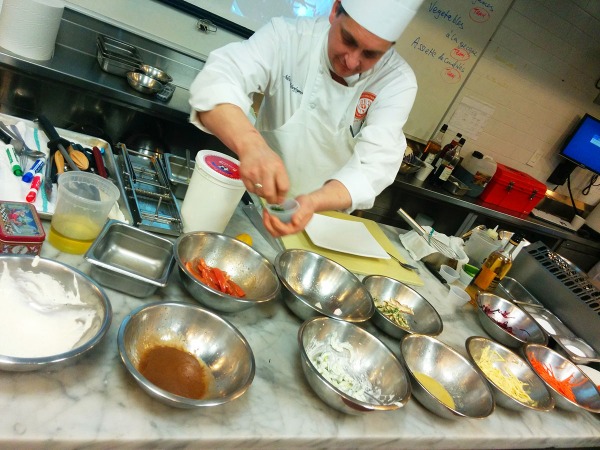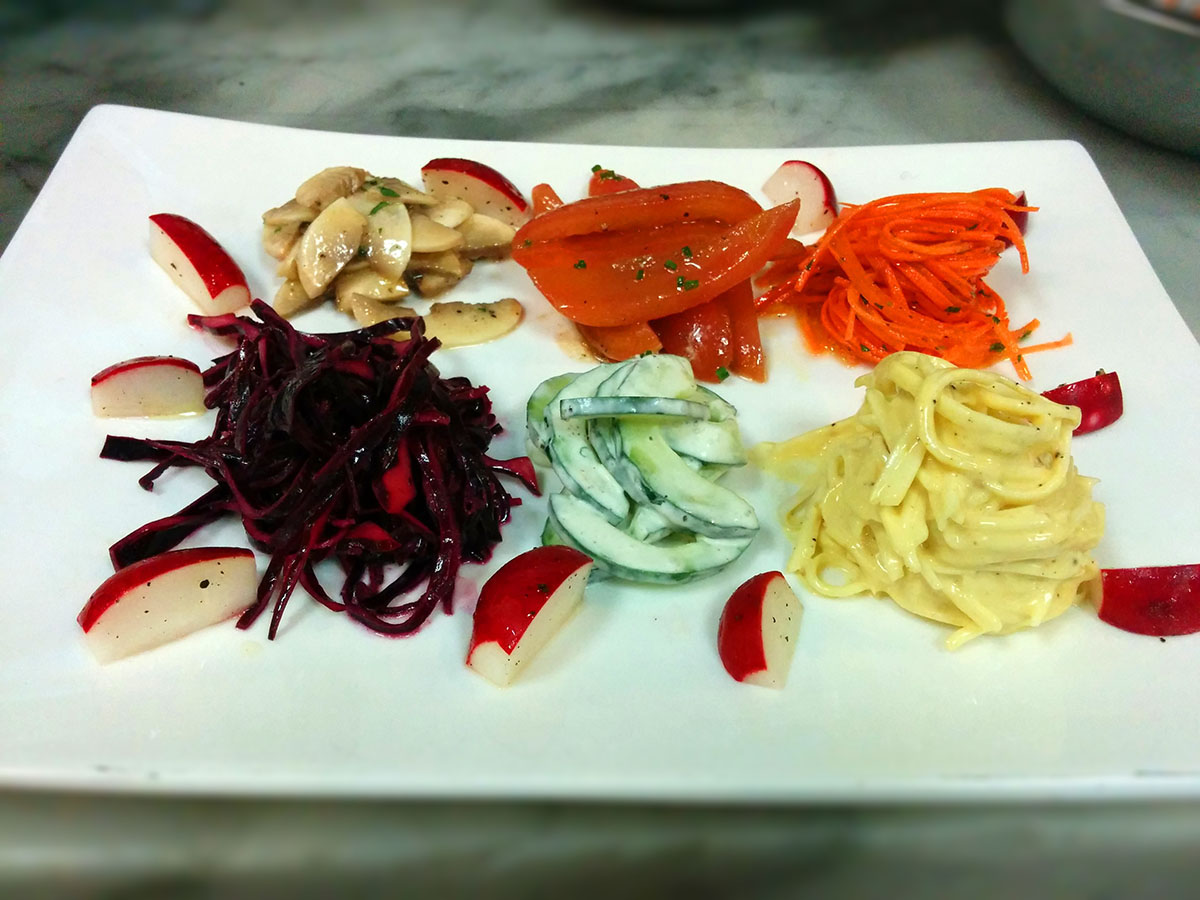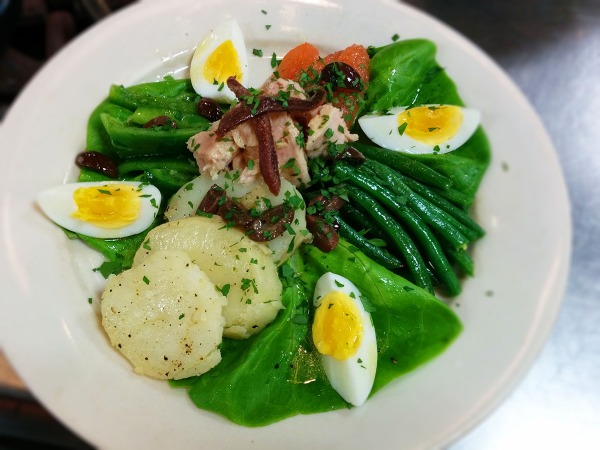The less photogenic dishes (sauces, knife work) are omitted, but otherwise this gallery gives you a pretty good sense of what you’ll be cooking in the Culinary Techniques class.
Tag Archives: International Culinary Center
What I Learned in Culinary School (and Why I’m Quitting)
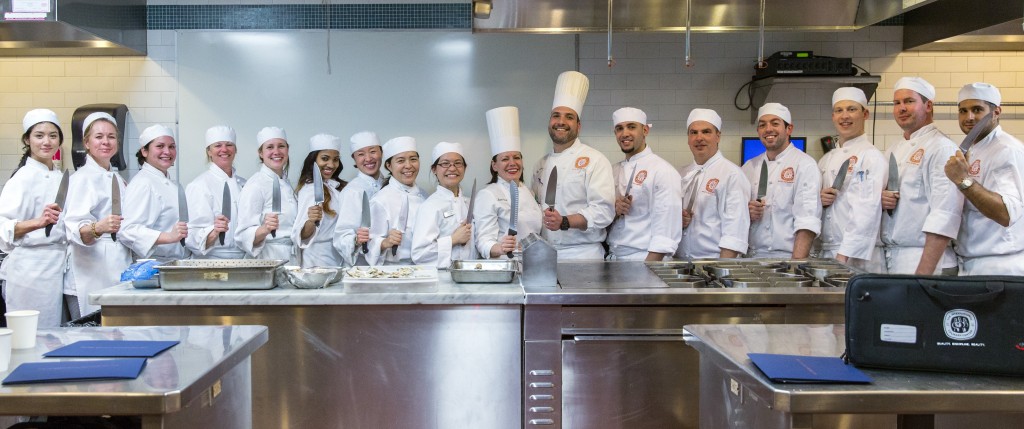
After 22 classes and 110 hours in the kitchens, I am sad but proud to have finished the Culinary Techniques course at the International Culinary Center.
We began on day one by struggling to chop some onions and carrots, and trying to memorize the French names of all the new equipment. Some of us cut ourselves simply pulling knives out of our bags. Somehow that lesson took five hours to cover. We were green as the tray of herbs that was passed around for an identification lesson.
By the last class, the metronome had sped up but we were keeping pace. Dice the mushrooms, cover them with parchment, reduce the sauce, steam the mussels, put everything together in a painstakingly labor intensive French fashion that looks and tastes better than any version you’ve cooked at home. The initial novelty had worn off, replaced by a comfortable autopilot.
In a nutshell, here’s what I learned in culinary school:
Continue reading What I Learned in Culinary School (and Why I’m Quitting)
Culinary School: Why I’m making the worst food of my life
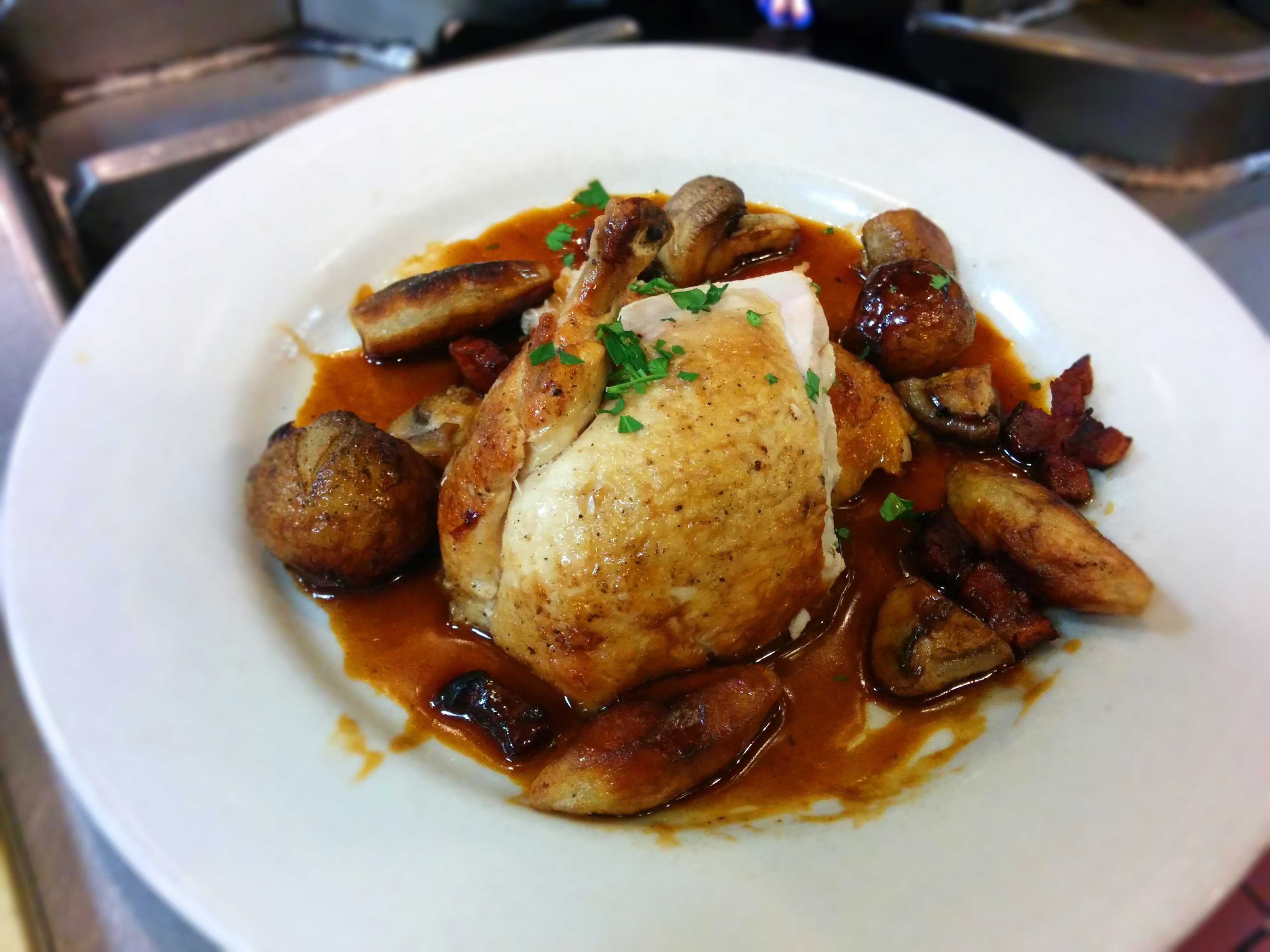
Nights in culinary class move in a dance of steel and time pressure. Yank out the wishbone. Quarter the chicken. Sear the skin. Chop the mirepoix. Simmer the stock. Strain the sauce. Pull the chicken from the oven. Plate the food. Run to the front. Hope for the best.
Chef Ray glanced at my plate of poulet sauté chasseur (hunter-style chicken) and gave me a hard look. “I think I’ve told you this before,” he said. “This plate. What’s wrong with it?” I looked down at my chicken. Among the finely shredded flakes, there were some unruly tufts of parsley perched on top, shamelessly advertising their prowess at escaping my knife. “I know, I know,” I apologized, “the parsley isn’t chopped small enough. And there’s some pieces of stems.”
With a spoon, he pointed at a resolutely intact parsley leaf. “Look,” said Chef Ray, “you spent two hours making this dish, and you put herbs like this on the plate it and it just ruins the presentation.” He chased the offending chunk of parsley to the edge. “The chef that taught me insisted on really finely chopped herbs, so since that’s how I was taught, this is a pet peeve of mine too.” Chef Ray prodded at the chicken. “This is cooked well, it’s not overdone and the skin looks great. But you put parsley like that on the plate and that’s the first thing you see.” I bowed my head. “Yes, Chef.” He sighed. “All right, start cleaning up.”
God damn it, I hate chopping herbs.
You know what it looks like when Chinese people chop herbs? Like a lawnmower belched huge piles of foliage on the table. And that’s perfect. We embrace chunky cilantro and scallions like Sir Mix-a-Lot loves chunky booty. Let me show you some examples:
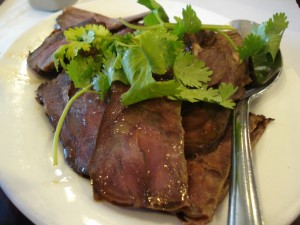
Here’s a plate of Five Spice Beef from China House in Mountain View. It looks like they didn’t bother chopping anything, they just threw entire stalks of cilantro on the plate.
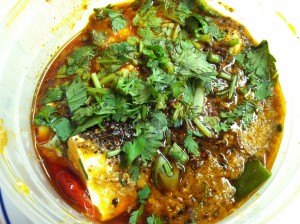
Maybe we need to look at a better restaurant? Cult favorite Mission Chinese Food in San Francisco has won all sorts of awards, so let’s take a look at their mapo tofu. Yup, you can definitely see big pieces of leaves and stems floating on that chili oil.
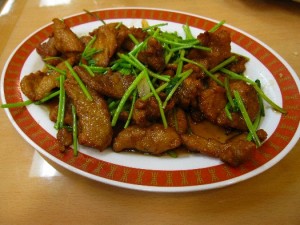
And my personal favorite, Double Cooked Pork from Happy Kitchen in LA. THEY ONLY USED CILANTRO STEMS!
Let’s review the most common culinary school sins:
- Plate not hot enough (forgot to put it in the oven)
- Plate too hot (forgot to take it out of the oven)
- Sauce underreduced and not nappant (sticks to the back of the spoon)
- Sauce overreduced and too thick
- Vegetables not brown enough or too brown/burnt
- Meat under or overdone
- Vegetables not cut uniformly (see taillage)
- Not enough acid (lemon juice)
- Food not salty enough (I’ve never been told my food’s too salty, even when I try to overseason)
- Too much grease
- Too much sauce (pooling at bottom of plate)
- Sauce drips on plate edge
- Using black pepper in a white dish (where’s your white pepper idiot?)
- And of course, my #1 nemesis, the herb garnish is too big
In other words, no matter how hard you try, your plate is never good enough. Wait, this is starting to sound familiar…

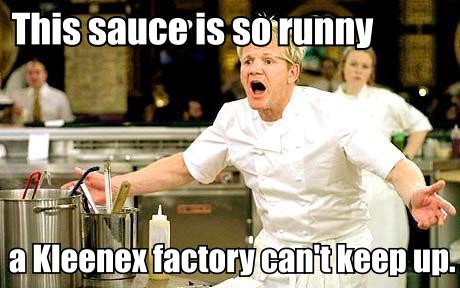

Maybe the solution is to give up on cooking?

At least my extra tournage work at home paid off. Chef Ray looked at my potato cocottes and said they looked great without other comment. Phew.
I can’t even imagine how much of a pressure cooker it would be to compete on TV. (Well, maybe I can. This piece from pastry chef Allison Robicelli is a hilarious read if you’d like to hear more.) I would have a nervous breakdown. Or start pouring fish sauce on the judges’ cars.
Whatever. My new favorite food photography blog is now Dimly Lit Meals for One (exactly what it sounds like).
Clearly the solution is to start chopping like this guy:
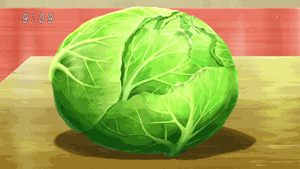
“Hit It Like a Mal Boyfriend” and Other Lessons from Chef François Payard
François Payard is a top pastry chef, a long-standing innovator in New York’s dessert scene and winner of a James Beard award in 1995. Which is why it’s incredibly jarring when he’s looking at you from 10 feet away, asking what’s in egg whites. “Yes you, I’m looking at YOU in the second row,” he says. “Uh,” you stammer, “it can’t be lecithin because that’s in yolks…so albumin?”
Payard was giving a pastry demo for students at the International Culinary Center, and we were all there to learn some of his techniques (and secretly hoping for dessert samples). Today’s tasks: chocolate phyllo dough, caramel, chocolate rice crispies, chocolate chantilly cream. With a comfortable patter, he explained the steps he was taking while quizzing us to make sure we were paying attention. “I don’t make the phyllo dough, I buy it, like everybody else. Now, brush clarified butter and cocoa on phyllo, and between each layer, sprinkle some sugar to allow caramelization. It comes out almost like puff pastry, or if you didn’t know better, you’d think it was bad puff pastry because you have the layers but it doesn’t rise.” He picked up a heavy pan. “We want to make sure it stays flat, so then you”—whack!—”hit it like a mal boyfriend, with the back of a pan or a rolling pin.” He added more phyllo, butter and cocoa in repeating layers. “What’s the best way to cook phyllo dough?” he asked. “Use a sheet pan, upside down, with at least three trays on top to make sure it stays flat. See, all these little things will make you a chef, not a student. Always ask why you’re doing something. I’m not here to show you what I can do, I’m here to show you what you can do.”
Payard continued. “We want to make an incredible caramel. What will help give flavor to my caramel? You, in the middle.” The girl hesitated. “Salt?” she said. “Exactly,” said Payard. He demonstrated how to warm and whip cream to prevent it from exploding when being added to the sugar, and drizzled the caramel on white parchment paper to see if it was the right color. “Does anyone know what’s chocolate chantilly?” he asked. “It’s 2 cups heavy cream and 1 cup chocolate. Because it’s so simple, it’s easy to fuck it up. Your chocolate must be hot, and your cream must be cold. It’s all about technique.” Payard paused to look at us. “So, don’t fuck it up.”
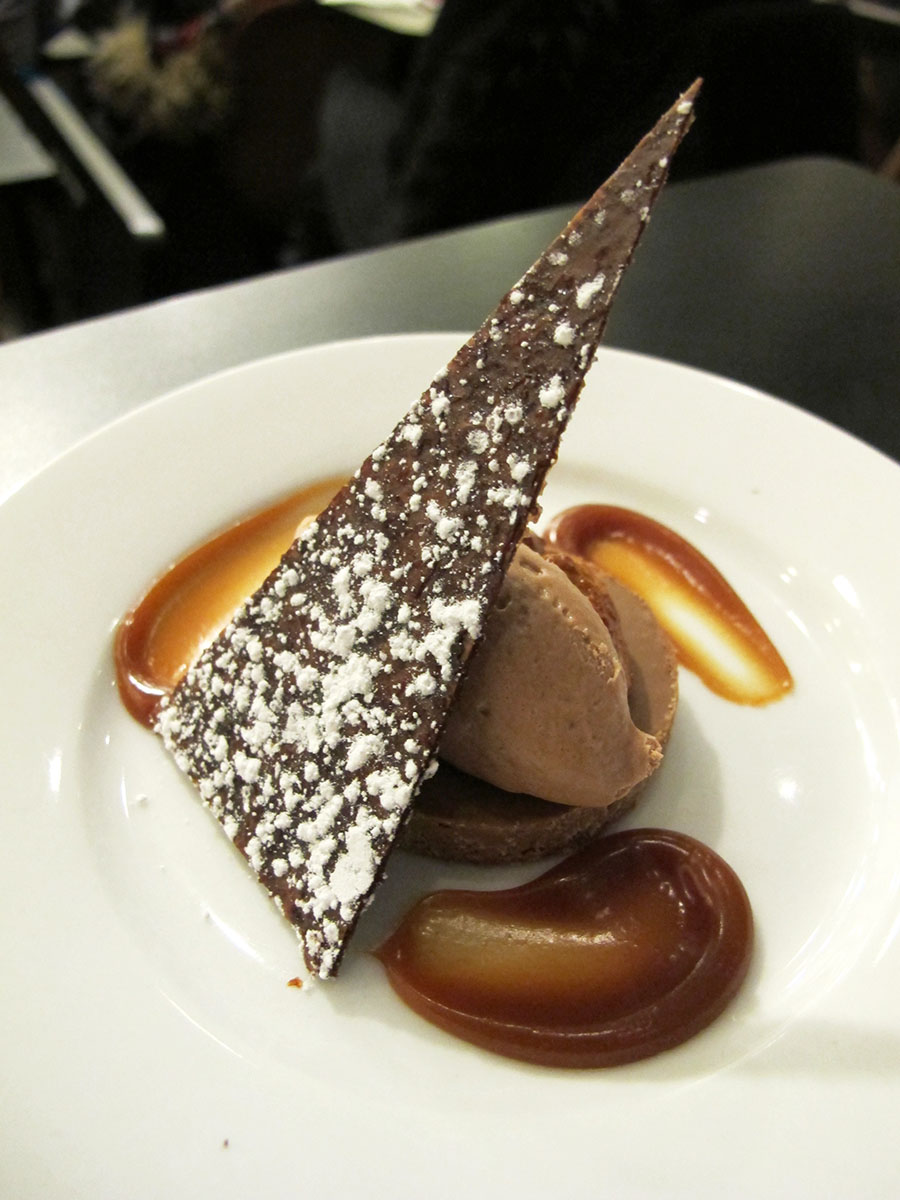
In a matter of minutes, all of these simple components were ready to come together. Payard used a ring mold to cut out a short cylinder of rice crispies, topped it with a plump dollop of chocolate chantilly and a sharp wedge of phyllo. With a sprinkle of powdered sugar and several smears of caramel on the plate, the composed dessert was as elegant as an Oscar gown. “It’s not about complication,” Payard explained, “it’s about the right ingredients.” He waved at his cookbooks, sitting on the edge of the workstation. “In America, no one likes this book because it’s too complicated. But you should look at the components, maybe there is a chocolate sauce that you can use, or something else that you can take away. Pastry is always time consuming. In a restaurant, you already have the chocolate sauce made, you always have rice crispies on hand. If you start from scratch, it will take you four hours.”
Continue reading “Hit It Like a Mal Boyfriend” and Other Lessons from Chef François Payard
Good Thing There’s Sauce: How to Butcher and Cook Whole Fish
Dear readers, I have a confession to make: while I work in the seafood industry and am an avid seafood lover, I have never filleted a fish. It’s not for a lack of opportunity per se. The thing is, I was raised in an Asian family where the policy on fish was, “If you can’t pick out the bones, then you don’t deserve to eat.” So we cleaved our fish into large steaks or steamed it whole, with a splash of soy sauce over a shower of ginger and scallion strips. It was simple and satisfying, no need to get fancy.
Which brings us to Fish Week, or lessons 8 and 9 at culinary school. “What’s wrong with just buying filleted fish?” someone asked. “Nothing,” replied Chef Ray, “except that you don’t really know how fresh it is. Unless they fillet it in front of you, you can’t check the eyes, the gills or the skin. You can only smell it for freshness. Hell, you don’t even know if it’s the fish they say it is.” We mulled that over. “This lesson was originally written so that each team fillets a fish together. But that’s silly, what’s the point of filleting just half of the fish?” said Chef Ray. “I ordered enough fish so that each of you can fillet one round fish and one flatfish. Let’s get to it.”
In just a few deft motions, Chef Ray slit the striped bass along its spine and gently removed a fillet. “Use long, smooth strokes guys. Don’t saw at it, and make sure you bend your knife so that it scrapes against the bones,” he instructed. You could hear his blade rasping against the spine. After both fillets were removed, Chef Ray slid his knife between the meat and skin, and gently stripped it away. What remained was a perfect slab of fish, pink and well shaped. It looked simple enough.
“Remember to always check the freshness of the fish before you start!” said Chef Ray. “Clear eyes, taut stomach, bright skin, gills full of blood, no fishy or off smells.” I blotted my fish with a clean towel to dry it, and began snipping off the fins with kitchen shears. “Watch out for the spikes in those dorsal fins, they can really hurt!” warned Chef Ray. With my fish knife (thin, flexible and very sharp), I began slicing against the spine. Wait, is that bone or meat? Why is the skin not slipping off? I glanced across at my partner’s fish; he’d already finished his fillets and was cleaning his carcass of entrails. “Five more minutes!” said Chef Ray. I hurried to remove the skin and yank the remaining pin bones out with pliers. Two fillets sat on the cutting board, mangled by cuts and disappointment.
The process for filleting flatfish is a little different than for round fish. Flatfish have four fillets, not two, and swim horizontally, with their bellies parallel to the seafloor. You begin by slitting down the center of the fish, following the spine, then take out two fillets from the top of the fish, and two from the underside of the fish. It’s much easier to fillet a flatfish and the fins are floppy, so you can’t stab yourself inadvertently. After tackling my flounder, I was left with four ragged but mostly respectable fillets, and a carcass which would be used for fish stock.
Continue reading Good Thing There’s Sauce: How to Butcher and Cook Whole Fish
Eat Your Veggies…Because They’re Surprisingly Fun to Cook
After several introductory classes of stock and sauce making, we moved into making complete dishes. Namely, salads, vegetable dishes and soups. I tried not to yawn. “Vegetables are important!” insisted my chef-friend Wendy. “It’s difficult to do them well.” I tried to muster some excitement, but the thought of making 6 different types of vinaigrette was already making my whisking arm ache.
In class, we were greeted by some new faces. Chefs Ray and Janet were taking time off and so we were under the tutelage of Chefs Dominique, Nicolay, Guido and Jose for a few lessons. Immediately, we had to adjust our bearings to the instructor. Chef Ray’s macedoine cut was a little larger than Chef Nic’s, so I scrapped my vegetables and started over, lest we get chastised for improper taillage.
Chef Nic was also much heavier handed with seasoning. When we were repeatedly told that our food didn’t have enough salt or lemon, we would add more to the next dish. Finally, for our final plate of celery rémoulade, I dumped a big scoop of mustard and salt into the bowl, then tasted the celery root. Horror curled my tongue. “I think it’s too salty,” I whispered to my partner. “Oh no, what do we do?” He swiped at the sauce and said, “Actually, I think it’s fine, it just needs a little more lemon.” We brought our assiette de crudités up to the front and held our breath. “There’s too much dressing on the mushrooms, see how it’s pooling on the plate here?” said Chef Nic. “Also, there’s a little too much dressing on the celery root. But other than that, it’s fine.” I couldn’t believe my ears. “So, the celery rémoulade is not too salty?” I asked. “Nope, it’s just right,” Chef Nic replied. “Remember, restaurant food is paired with wine, and needs to be saltier than food eaten without wine. If you have a table where everyone is drinking wine except for one person, it’s not unusual for that one person to complain that the food is too salty, while everyone else is happy.”
So the salads, how did they taste? Turns out that when you treat each ingredient with care and allow its full expression to shine, salads can be flavorful, beautiful and dare I say it, exciting. We made a traditional salade niçoise, and each element was carefully washed, cut, seasoned and dressed to create a perfectly harmonious plate. “Why are you peeling the green pepper?” someone asked. “Because I don’t want the skin,” said Chef Dominique. We laughed. “Sometimes the skin can be a little tough or bitter, so I peel it,” Chef Dominique explained.
The macédoine de légumes cooked vegetable salad is actually one of my new all-time favorites, an exercise in how simple ingredients cooked well can come together to create something truly stunning. You make mayo and tomato sauce, then cut carrots, turnips, beans and peas into uniform pieces, cook each vegetable separately, then bind the vegetables together with the mayo and some basil puree, topped by a layer of tomato sauce. The result is creamy and acidic, sweet and savory, refreshing and satisfying. This was one of the most popular salads of the late 19th century, and is still often served in Parisian bistros today, but there probably aren’t any restaurants in NYC serving it now. Quel dommage!
Continue reading Eat Your Veggies…Because They’re Surprisingly Fun to Cook
